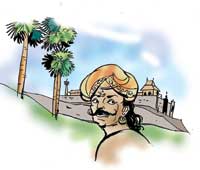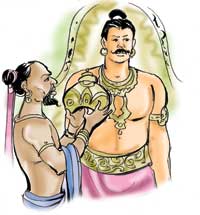1. In the latter part of his rule, King Veera Parakramabahu VIII, had divided the Kotte kingdom into four parts. His four sons – Dharma Parakramabahu, Vijayabahu, Rajasinghe and Raigam Bandara had been in charge of these four divisions. The king passed away in 1509 A.D. He was succeeded by his second son, Prince Vijayabahu. He was crowned as King Vijayabahu VI. However, it is the eldest son, Dharma Parakramabahu who would have remained as the lawful ruler, during the time of his father.
2. This fact is
mentioned in the Rajavaliya too. But there is not enough evidence to accept it. Scholars are of the opinion that, once the father king died, Vijayabahu would have come to power by force. In the fourth year of his rule, the king had donated land to the kovil in Dondra and installed a pillar
inscription, mentioning this. In this inscription, Vijayabahu's ascension to power is giver as 1509 A.D.
3. By this time, a lot of changes had taken place in the country. The island was divided into three
kingdoms of Kotte, Kandy and Jaffna according to the book 'Ceylon History,' by Rev.Fr. S. G. Perera. According to him, the most important of the three – was the Kotte kingdom. The governors appointed by the king, had ruled the seven korales, four korales, three korales, two korales and the two 'disaves' of Raigama and Matara.
4. This king inherited all the splendour and the tradition of the line of Sinhala kings. He claimed ownership of the other kingdoms too. For these reasons – the king was named 'Chakravarti' or 'Rajadhiraja.' The Yuvarajas, princes and the ruler of the other areas should actually present themselves with tribute. The funds, thus obtained were used for the annual 'Perahera' in Kotte. They had to come with a crowd. This procession was held for 16 nights. Anyone who failed to participate in the procession had to face severe punishment.
5. In the Jaffna kingdom, the language used was Tamil. This kingdom included the peninsula of Yaalpa, the surrounding little islands and the coast line up to Mannar. The people who lived here were Hindus. They are described as the people who came here to fight in wars. Before that, Buddhists lived here. The ruins of temples found in Jaffna and the original Sinhala names which were given a Tamil pronunciation, bear evidence to this fact.
6. In the 13th century A.D., this was a powerful Tamil kingdom. Then they had received tribute from the other kings as well. At one time, it was under the king of Kotte. It became
independent once more, in the 16th century A. D. Yet Kotte did not relinquish the ownership of this part of the country. The capital city of Jaffna was Nallur and it was a powerful town. We have spoken about Jaffna, in our earlier
articles as well.
7. The Kingdom of Kandy consisted of the
following areas. The
central hill country, Kotmale and
Uda-Bulathgama, which made Udunuwara, Yatinuwara, Dumbara, Tumpane, Harispattuwa and Hewaheta. This area was named 'Kanda-uda-pas-rata' or Udarata. The Europeans used the name Kandy. In early days, the king's palace was built in Gampola, close to the Mahaweli ganga. In about 1540 AD, the Senkadagala Kingdom was shifted to Kandy.
8. Those who ruled the Kandyan Kingdom had to pay tribute, to the kings of Kotte. Very often they were leaders who were related to the line of kings of Kotte. In the midst of all this, there were petty kingdoms too. They were named Vanni. It is where such a type of administration existed here, that the Portuguese came to
Sri Lanka. |



